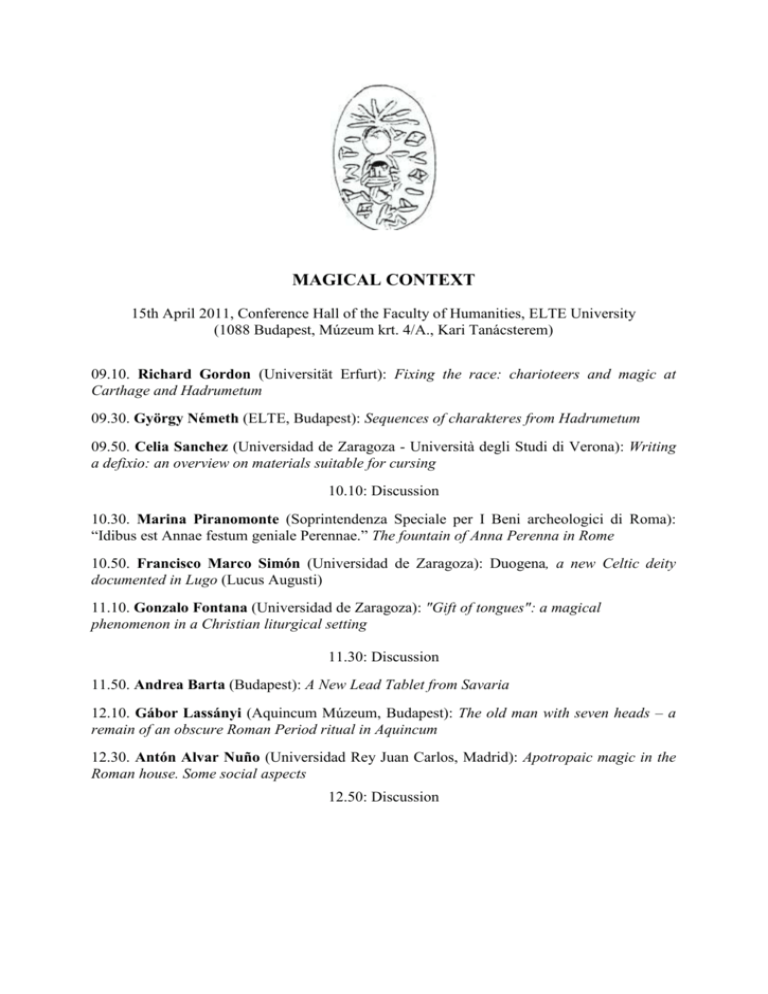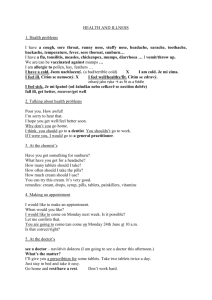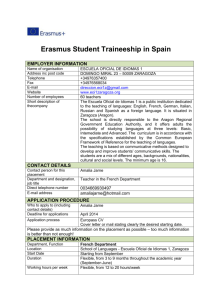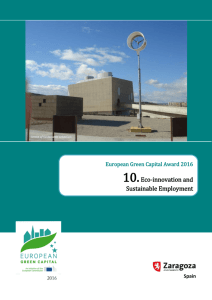MAGICAL CONTEXT
advertisement

MAGICAL CONTEXT 15th April 2011, Conference Hall of the Faculty of Humanities, ELTE University (1088 Budapest, Múzeum krt. 4/A., Kari Tanácsterem) 09.10. Richard Gordon (Universität Erfurt): Fixing the race: charioteers and magic at Carthage and Hadrumetum 09.30. György Németh (ELTE, Budapest): Sequences of charakteres from Hadrumetum 09.50. Celia Sanchez (Universidad de Zaragoza - Università degli Studi di Verona): Writing a defixio: an overview on materials suitable for cursing 10.10: Discussion 10.30. Marina Piranomonte (Soprintendenza Speciale per I Beni archeologici di Roma): “Idibus est Annae festum geniale Perennae.” The fountain of Anna Perenna in Rome 10.50. Francisco Marco Simón (Universidad de Zaragoza): Duogena, a new Celtic deity documented in Lugo (Lucus Augusti) 11.10. Gonzalo Fontana (Universidad de Zaragoza): "Gift of tongues": a magical phenomenon in a Christian liturgical setting 11.30: Discussion 11.50. Andrea Barta (Budapest): A New Lead Tablet from Savaria 12.10. Gábor Lassányi (Aquincum Múzeum, Budapest): The old man with seven heads – a remain of an obscure Roman Period ritual in Aquincum 12.30. Antón Alvar Nuño (Universidad Rey Juan Carlos, Madrid): Apotropaic magic in the Roman house. Some social aspects 12.50: Discussion Abstracts Antón Alvar Nuño (Universidad Rey Juan Carlos. Madrid) Apotropaic magic in the Roman house. Some social aspects There are two main methodological approaches in relation to the study of apotropaic magic in the graeco-roman world. An historicist one, focused on the formal description of the data and on tracing their possible origins; and a psychologist-functionalist one, which interprets the data as a psychological relief to the anxieties produced by the misfortunes of daily-life. My purpose here is twofold: 1- relating apotropaic iconography and ritual practice in the Roman house to the Ideological Apparatuses of the State, and 2- reading them as symbolic representations of the existing relations of production. Barta Andrea (Budapest) A New Lead Tablet from Savaria A recently discovered lead tablet from the Iseum of Savaria seems to increase the small number of curse tablets found in Hungary. Though the rough handwriting makes difficult to read the two-sided text written probably completely in Latin, the exact information on the finding circumstances can help us to get clearer picture of this tabella. Richard Gordon (Universität Erfurt) Fixing the race: charioteers and magic at Carthage and Hadrumetum Focusing mainly on the Classical period, E. Eidinow in her recent book, Oracles, curses & risk (2007) does not discuss the social context of one important type of binding curse, those directed at charioteers (and, much less common, athletes and venatores). Although the genre was no doubt established in the eastern Mediterranean, the Project’s concentration on the Latin-speaking West induces me to select the material from Carthage and Hadrumetum (conveniently collected by J. Tremel [2004]), whose bilinguals reveal a fascinating interaction between Greek and Latin modes. I propose to look briefly at 1) the reasons for the (late) emergence of the genre; 2) the rhetorical construction of the curses; 3) the question of risk: whose risk is being reduced by such curses? 2 Gonzalo Fontana (Universidad de Zaragoza) Gift of tongues": a magical phenomenon in a Christian liturgical setting The "gift of tongues" is a phenomenon originating in well-known magical rituals in many cultures. In the case of early Christianity, it was introduced into the liturgies of communities in Corinth and Rome by new believers of Gentile upbringing whose religious experience already included it. Francisco Marco Simón (Universidad de Zaragoza) Duogena, a new Celtic deity documented in Lugo (Lucus Augusti) Excavations in the Plaza do Ferrol in Lugo (Galicia, Spain) during 1986 brought to light a necropolis with cistae datable from the middle of the 1st century to the end of the 3rd. On one of the funerary urns (with a typology pointing to the first half of the 3rd century), a graffito was written with a formula execrationis invoking Duagena to punish the possible looters. The theonym, a hapax, seems to belong to Celtic chthonic goddesses, whose personality (“Born Dark”, or “Born from Darkness”) finds parallels in other magical texts (e.g. Antumnos in Les Martres de Veyres). Lassányi, Gábor (Aquincum Múzeum, Budapest) The old man with seven heads – remains of an obscure Roman Period ritual in Aquincum In 2007, a mysterious grave of an elderly man was excavated in the Eastern cemetery of the Civil Town of Aquincum. In fact the grave itself was all means an ordinary Roman Period inhumation grave, however, a secondary pit containing five carefully arranged human and one horse skull was dug shortly after the burial. Although the analysis of the contents of this secondary pit suggested that it was most likely the remain of a yet unknown ritual, this hypothesis remained to be proven. However, researches and consultations with colleagues later revealed the existence of a second, yet unpublished similar pit containing four human skulls, overlying a rather contemporary grave excavated some 30 years ago from the close vicinity, alongside with a third, unfortunately poorly documented triple skull burial discovered in 1956. These data are suggesting the existence of as far as the contributor knows yet undescribed magical ritual involving human skulls performed in Roman Period cemeteries. 3 Németh, György (ELTE, Budapest) Sequences of charakteres from Hadrumetum A peculiar feature of curse tablets from Hadrumetum (published by Audollent in his Defixionum tabellae in 1904 and in a study of his in 1906) is that these tablets present recurring sequences of magical charakteres. We find one of the four sequences in one single tablet, another sequence in three tablets, while the third sequence occurs in five tablets, yet there is also one sequence which is found 34-times in ten tablets. All defixiones are curses against participants of chariot-races, i.e. charioteers and horses, and some charioteer names show up in nearly all lead tablets. The appearance and physical size of the lamellae differ considerably. The curse against horses refers to charioteers without even giving their names. The data allows us to conclude that there was a circle of magicians, using the same handbook and specialised in chariot-racing, who invented the recurring sequences of charakteres, though – in our knowledge – their innovation was not adopted in other regions. Marina Piranomonte (Soprintendenza Speciale per I Beni archeologici di Roma) “Idibus est Annae festum geniale Perennae.” The fountain of Anna Perenna in Rome The archaeological discovery of the fountain of Anna Perenna enriches our knowledge on ancient magic and superstition. Rome has spoilt us with sensational and continuous archaeological discoveries. One can say that nearly every building intervention in the city has brought about findings, some extraordinary and others more modest, however, they all enrich the historical scenario of our very beautiful URBS. Recently the works for new tracks of underground and, above all, the policy to build underground parking lots in various areas so as to resolve the age-old problem of parking spaces in the city have given a hand to archaeologists, who find themselves, as I did, discovering archaeological sites, even extraordinary ones like that of the Anna Perenna Fountain, in 1999, during the excavations for the construction of an underground parking lot. The discovery of the fountain is extraordinary because it gives us much information about the relationship that ancient Romans had with magic. Celia Sanchez (Universidad de Zaragoza - Università degli Studi di Verona) Writing a defixio: an overview on materials suitable for cursing The aim of this paper is to analyze binding curse tablets found in the Latin West from a material perspective, in order to rethink their multifaceted nature, since defixiones were not always inscribed in pieces of lead. 4








